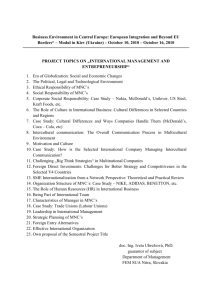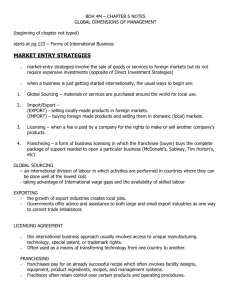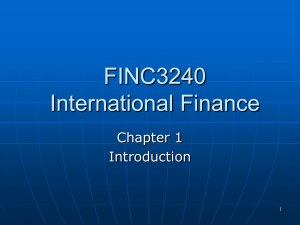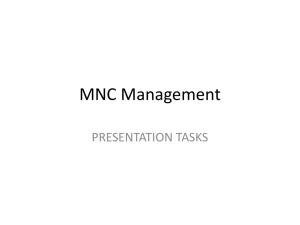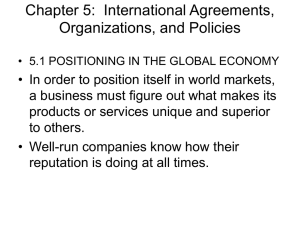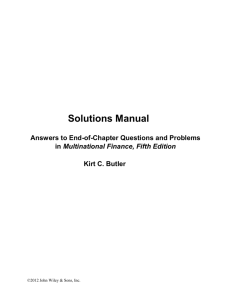FIN575 – International Financial Management
advertisement
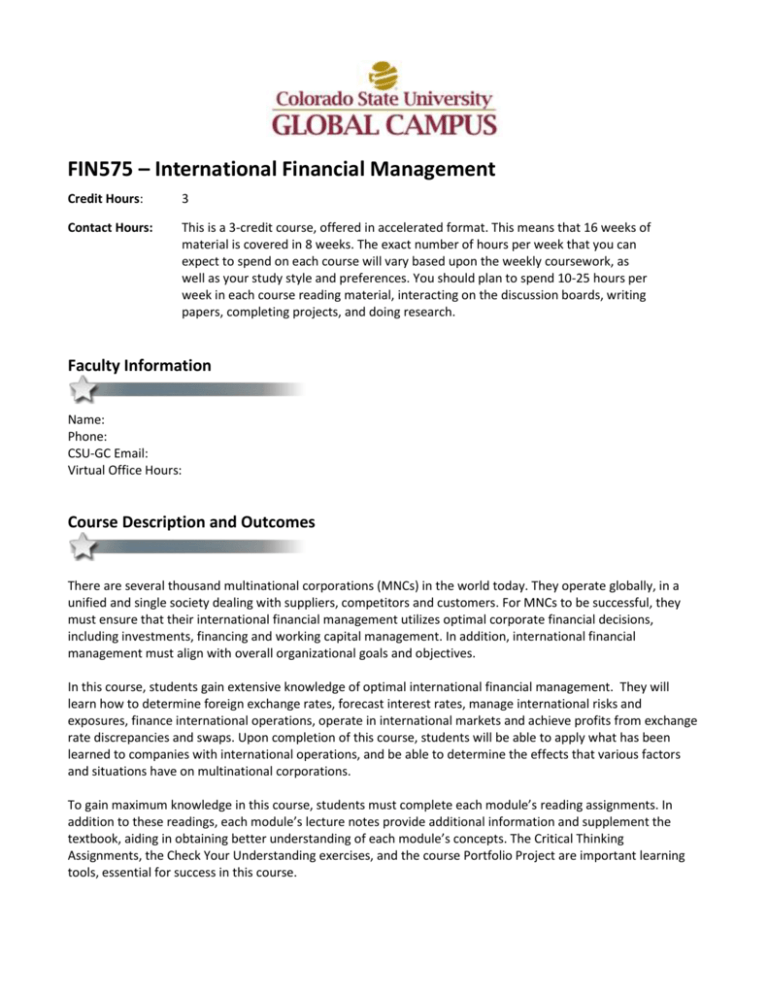
FIN575 – International Financial Management Credit Hours: 3 Contact Hours: This is a 3-credit course, offered in accelerated format. This means that 16 weeks of material is covered in 8 weeks. The exact number of hours per week that you can expect to spend on each course will vary based upon the weekly coursework, as well as your study style and preferences. You should plan to spend 10-25 hours per week in each course reading material, interacting on the discussion boards, writing papers, completing projects, and doing research. Faculty Information Name: Phone: CSU-GC Email: Virtual Office Hours: Course Description and Outcomes There are several thousand multinational corporations (MNCs) in the world today. They operate globally, in a unified and single society dealing with suppliers, competitors and customers. For MNCs to be successful, they must ensure that their international financial management utilizes optimal corporate financial decisions, including investments, financing and working capital management. In addition, international financial management must align with overall organizational goals and objectives. In this course, students gain extensive knowledge of optimal international financial management. They will learn how to determine foreign exchange rates, forecast interest rates, manage international risks and exposures, finance international operations, operate in international markets and achieve profits from exchange rate discrepancies and swaps. Upon completion of this course, students will be able to apply what has been learned to companies with international operations, and be able to determine the effects that various factors and situations have on multinational corporations. To gain maximum knowledge in this course, students must complete each module’s reading assignments. In addition to these readings, each module’s lecture notes provide additional information and supplement the textbook, aiding in obtaining better understanding of each module’s concepts. The Critical Thinking Assignments, the Check Your Understanding exercises, and the course Portfolio Project are important learning tools, essential for success in this course. Course Learning Outcomes: 1. Explain the international flow of funds and the mechanism for international payments. 2. Compute and discuss arbitrage, interest rate parity, purchasing power parity and international Fisher effect. 3. Identify and describe international financial markets, institutions, and instruments and analyze interest rate markets and swaps. 4. Explain the mechanisms for forecasting exchange rates. 5. Manage transaction, economic, and translation exposure. 6. Analyze country risk exposure. Participation & Attendance Prompt and consistent attendance in your online courses is essential for your success at CSU-Global Campus. Failure to verify your attendance within the first 7 days of this course may result in your withdrawal. If for some reason you would like to drop a course, please contact your advisor. Online classes have deadlines, assignments, and participation requirements just like on-campus classes. Budget your time carefully and keep an open line of communication with your instructor. If you are having technical problems, problems with your assignments, or other problems that are impeding your progress, let your instructor know as soon as possible. Course Materials Required: Shapiro, A.C. (2010). Multinational financial management (9th ed.). Hoboken, NJ: John Wiley & Sons. ISBN13: 9780470415016. Course Schedule Due Dates The Academic Week at CSU-Global begins on Monday and ends the following Sunday. Discussion Boards: The original post must be completed by Thursday at 12 midnight MT and Peer Responses posted by Sunday 12 midnight MT. Late posts may not be awarded points. Critical Thinking Activities: Assignments are due Sunday at 12 midnight MT. Week # 1 2 Readings Chapter 1 in Multinational Financial Management Chapters 3 & 5 in Multinational Financial Management Assignments Discussion (25 points) Critical Thinking (50 points) Discussion (25 points) Critical Thinking (60 points) 3 4 5 6 7 8 Chapters 7 & 12 in Multinational Financial Management Chapter 9 in Multinational Financial Management Chapters 10 & 11 in Multinational Financial Management Chapter 6 in Multinational Financial Management Chapter 4 in Multinational Financial Management Chapter 2 in Multinational Financial Management Discussion (25 points) Critical Thinking (90 points) Discussion (25 points) Critical Thinking (55 points) Discussion (25 points) Critical Thinking (70 points) Discussion (25 points) Critical Thinking (50 points) Discussion (25 points) Critical Thinking (75 points) Discussion (25 points) Portfolio (350 points) Assignment Details This course includes the following assignments/projects: Module 1 Critical Thinking: Globalization—The Reasons and the Risks (50 points) Write a response to the following questions: 1. 2. 3. Discuss possible reasons a corporation may want to grow its international business. Describe the risks that a potential multinational corporation may no longer face as it ceases to be a domestic corporation. Discuss total and unique risks for a potential multinational corporation. Your essay must be in a Word document of 3-5 pages in length, well-written, with at least three resources cited in conformity with CSU-Global guidelines for APA Style. The CSU-Global library is a great place to find resources! Module 2 Critical Thinking: Cross Rates, Devaluation, Cost of Intervention and Balance of Payments (60 points) 1. On July 2, 2012, the cross rates for the Japanese and Mexican currencies were yen 0.009949/EUR and peso 0.059571/EUR. What are the cross rates between the two currencies? 2. Suppose that on July 2, 2012, the cross rates for the Singapore and South African currencies were Singapore dollar (S$) 0.789085/US dollar (US$) and rand 0.122540/US$. What are the cross rates between the two currencies? 3. Assume the Bank of Germany borrowed Australian dollar (A$) 25 billion from the Bank of Australia before the global financial crisis of 2007. At that time, the rate was A$ 1.68751/€ or US$1.4786 /€. In 2012, the Bank of Australia repaid the money borrowed. At the time of repayment, the rate was A$1.22829/€ or US$ 1.25929/€: a. Calculate the percentage of devaluation of euros against Australian dollars as well as euros against U.S. dollars. b. Calculate the cost of intervention to the Bank of Germany in euros and U.S. dollars. 4. Record a journal entry for each of the following transactions: a. A U.S.-based MNC invests $800 million in a factory located in South Africa and finances the project by issuing bonds in Germany. b. A Mexican company sells $5 million worth of goods to an Arizona company and deposits the check in a bank in Scottsdale. c. The Bank of Denmark purchases 1.3 billion dollars in the foreign exchange market to hold down the value of the krone and uses these dollars to buy U.S. Treasury bonds. d. A U.S.-based MNC pays $9 million in dividends to foreign residents. Those residents decide to hold the dividends in bank deposits in New York. e. A U.S. car manufacturer exports $110 million of cars to the Philippines and receives payment in the form of a check drawn on a U.S. bank. 5. Calculate and record the following entries in the U.S. balance of payments accounts as applicable: a. The U.S. government uses its foreign demand deposits to purchase $8 from private foreigners in the U.S. b. American tourists spend $30 abroad using traveler's checks drawn on U.S. banks. c. The U.S. government sells abroad $45 in gold for foreign demand deposits. d. The U.S. exports $300 of goods and receives payment abroad in the form of foreign demand deposits. e. U.S. citizens purchase foreign stocks with $60, using foreign demand deposits held abroad. f. The U.S. imports $225 of goods and pays for them by drawing down its foreign demand deposits. g. The U.S. pays $15 to foreigners in dividends drawn on U.S. demand deposits. Your answers must be presented in a Word document; if you do any calculations in Excel, copy and paste them from Excel into the Word document. Make sure your responses are clearly marked so your instructor knows which questions your responses are answering. Written comments must be formatted in conformity with CSU-Global guidelines for APA Style. PORTFOLIO PROJECT: Choice of a Multinational Company (0 points) This week, submit the name of the multinational company (MNC) you propose to use for your Portfolio Project as well as the reason(s) for choosing the MNC, for approval. Submit these to your instructor by email by the end of the week. Your instructor will provide feedback about your choice. This is a required component of the Portfolio Project assignment, due this week. No points will be assigned for this, but points will be deducted from your final grade on the Portfolio Project if you fail to submit this assignment by week’s end. Module 3 Critical Thinking: Forward Discount and Premium, Arbitrage and Currency Exchange, and MNCs’ Reasons for Foreign Capital Markets’ Usage (90 points) 1. Use information from the table below to calculate the 30-day, 60-day and 180-day discount or premium for the Mexican peso. Spot: MXN 1 = $13.3694 30-day forward: MXN 1 = $13.3488 90-day forward : MXN 1 = $13.2219 180-day forward: MXN 1 = $13.1888 2. Use information from the table below to calculate the 30-day, 60-day and 180-day discount or premium for the euro. Spot: Euro 1 = $0.7931 30-day forward : Euro 1 = $0.7942 90-day forward: Euro 1 = $0.7943 180-day forward Euro 1 = $0.7948 3. Assuming there are no transaction costs and supposing that £1 = $1.563740 in New York, $1 = € 0.796178 in Paris, and €1 = £0.803199 in London, calculate the arbitrage opportunities that exist based on these rates. 4. Suppose Microsoft Corporation (Microsoft) receives quotes of $0.012524 (bid) and $0.012526 (ask) for the yen( ¥) and $0.033540 (bid) and $0.033541 (ask) for the Taiwan dollar (NT$). a. How many U.S. dollars will Microsoft receive from the sale of ¥60 million? b. What is the U.S. dollar cost to Microsoft if it buys ¥1.2 billion? c. How many NT$ will Microsoft receive for U.S. $700, 000? d. How many yen will Microsoft receive for NT$400 million? e. What is the yen cost to Microsoft of buying NT$82 million? 5. In a 2-3 page document, discuss reasons that MNCs list their shares on foreign capital markets. Your answers must be presented in a Word document; if you do any calculations in Excel, copy and paste them from Excel into the Word document. Make sure your responses are clearly marked so your instructor knows which questions your responses are answering. Written comments must be formatted in conformity with CSU-Global guidelines for APA Style. This assignment should amount to 2-3 pages of text in addition to your responses for questions 1-4. Module 4 Critical Thinking: Currency and Interest Rate Swaps (55 points) 1. Japanese investors purchased from Walt Disney Productions projected yen royalties. The 20-year stream of royalties is for Tokyo Disneyland. The present value of that stream of royalties, discounted at 5 percent (the return required by the Japanese investors), was ¥95 billion. Disney took the yen proceeds from the sale, converted them to dollars, and invested the dollars in bonds yielding 8 percent. At the time of the sale, the exchange rate was ¥79.8408 = $1. a. b. What amount (in dollars) did Disney realize from the sale of its yen proceeds? Describe the similarities and differences between Walt Disney's transaction and a currency/interest rate swap. 2. Coca-Cola is considering entering into a currency swap involving $14 million of U.S. debt for an equivalent amount of euro debt. Assuming the swap matures in 10 years, the interest rate on Pfizer’s outstanding 8-year dollar debt is 8% (paid semi-annually), the interest rate on the euro debt is 6 percent (paid semi-annually), and the current spot exchange rate is $1.24/€; structure a swap for Coca-Cola. 3. IBM wants to swap out of $10,000,000 of fixed interest rate debt and into floating interest rate debt for 3 years. Assume the fixed interest rate is 7.625 percent and the floating rate is dollar LIBOR. What semiannual interest payments will IBM receive and what will IBM pay? (Hint: A table of interest paid and received by IBM and the financial institution will help). Your answers must be presented in a Word document; if you do any calculations in Excel, copy and paste them from Excel into the Word document. Make sure your responses are clearly marked so your instructor knows which questions your responses are answering. Written comments must be formatted in conformity with CSU-Global guidelines for APA Style. Module 5 Critical Thinking: Translation, Transaction and Economic Exposures (70 points) 1. Assume that General Electric (GE)’s current assets are $401 billion, fixed assets are $797 billion, current liabilities are $323 billion, and long-term liabilities are zero. Calculate GE’s translation exposure using current/noncurrent, monetary/nonmonetary, temporal, and current rate methods. (Hint: You won’t be able to calculate using all the four methods based on given information. If you can’t calculate using a method, state so and include the reason.) 2. Toyota has exposed assets of ¥7 billion and exposed liabilities of ¥5 billion. During the year, the yen appreciates from ¥110/$ to ¥80/$. a. What is Toyota's net translation exposure at the beginning of the year in yen? In dollars? b. What is Toyota's translation gain or loss from the change in the yen's value? c. At the start of the next year, Toyota adds exposed assets of ¥1.5 billion and exposed liabilities of ¥2 billion. During the year, the yen depreciates from ¥80/$ to ¥115/$. What is Toyota's translation gain or loss for this year? d. What is Toyota’s total translation gain or loss for the two years? 3. Suppose an agribusiness in Texas exports its crops. It expects an 18 million peso invoice for an export to Mexico to be paid in 90 days. The current spot and 90-day forward rates are $0.7502/Peso and $0.7422/Peso respectively. a. b. c. 4. Calculate the company’s peso transaction exposure associated with this fee. If the spot rate expected in 90 days is $0.7489, what is the expected U.S. dollar value of the invoice? What is the hedged dollar value of the invoice? A U.S.-based MNC imports 30 percent of its supplies from Europe. Exports to Europe, which are invoiced in euros, account for approximately 50 percent of its revenues. In 1-2 pages, explain how the MNC can reduce its economic exposure to exchange and interest rates fluctuations. Your answers must be presented in a Word document; if you do any calculations in Excel, copy and paste them from Excel into the Word document. Make sure your responses are clearly marked so your instructor knows which questions your responses are answering; note that your response for question 4 alone should amount to 1-2 pages. Written comments must be formatted in conformity with CSU-Global guidelines for APA Style. PORTFOLIO PROJECT: Outline Draft of Portfolio Project (0 points) This week, submit an outline of your Portfolio Project. Submit this to the instructor by email by the end of the week. Your outline should be a Word document and you will list the major headings and sections of your paper. Your outline will be in this format: Title: The title or topic of your project. An example of a good title is “Nestle and the Global Credit Crisis of 2007.” Introduction: A paragraph of points that will be discussed about background Information or history of the MNC selected. Overview of the Global Credit Crisis: A paragraph of points that will be discussed in this section. Adverse Effects of the Credit Crisis on the MNC: Briefly identify the applicable adverse effects of the credit crisis on the MNC and its revenue. These may include: o exchange rates o credit access o international financial investments o transaction risk exposure o economic risk exposure o translation risk exposure o country risk exposure Assessment of MNC’s Current Financial Performance: A paragraph describing all points that will be discussed in this section. Assessment of MNC’s Future Financial Performance: A paragraph describing all points that will be discussed in this section. Conclusion: A paragraph describing all points that will be discussed in this section. References: An APA-formatted list of five to eight sources that will be cited in the paper. This draft is a required component of the Portfolio Project assignment. No points will be assigned for this, but points will be deducted from your final grade on the Portfolio Project if you fail to submit this assignment by week’s end. Module 6 Critical Thinking: Country Risk Exposure of MNCs (50 points) In early 2011, political revolution started in many Middle Eastern and African countries. Discuss the actual, probable and potential effects of the political turmoil on MNCs that operate in these countries. Specifically, describe the risk MNCs face while operating in these countries. In addition to utilizing the CSU Global library, consult web resources, such as www.moodys.com or www.standardsandpoors.com or www.fitchratings.com for the countries’ analyses and ratings. Your essay must be in a Word document of 3-5 pages in length, with at least three resources cited in conformity with CSU-Global guidelines for APA Style. Module 7 Critical Thinking: Interest Rate Parity, Inflation and Purchasing Power Parity (75 points) 1. Assume that the spot rate is €0.8144/$, the 180-day forward rate is €0.7933/$, and the 180-day dollar interest rate is 6 percent per year. What is the 180-day euro interest rate per year that would prevent arbitrage? 2. The consumer price index for the United States (U.S.) rose from approximately 121.4 in 1990 to approximately 199.3 in 2010. a. b. 3. How much inflation was there in the U.S. during the twenty-year period? What is the significance of the consumer price index to a multinational corporation? If the price level in Canada is C$18,500, the price level in France is €13,095, and the spot exchange rate is C$1.25/€, please answer the following questions: a. What is the internal purchasing power of the Canadian dollar? (Hint: it may be best to calculate the purchasing power of C$10,000 first and divide by the price level of C$18,500 to obtain the number of consumption bundles for C$18,500). b. What is the internal purchasing power of the euro in France? (Hint: it may be best to calculate the purchasing power of €10,000 first and divide by the price level of €13,095 to obtain the number of consumption bundles for €13,095). c. What is the implied exchange rate of C$/€ that satisfies absolute PPP? d. Is the euro overvalued or undervalued relative to the Canadian dollar? Explain the reasoning for your answer. Your answers must be presented in a Word document; if you do any calculations in Excel, copy and paste them from Excel into the Word document. Make sure your responses are clearly marked so your instructor knows which questions your responses are answering. Written comments must be formatted in conformity with CSU-Global guidelines for APA Style. Module 8 Portfolio Project: The Global Financial Crisis and Multinational Corporations (350 Points) The global financial crisis started in 2007, producing adverse effects on multinational companies (MNCs). Select one MNC based in the United States or another country. Compare its financial performance from 2007 through June 2008 to its performance from July 2008 (when the international credit crisis intensified) to the present. In your paper, analyze how and why the international credit crisis affected the MNC’s financial performance. Address the following questions: 1. 2. 3. 4. 5. 6. 7. Was the MNC’s revenue reduced due to weak global economic conditions? Was it adversely affected because of how the international credit crisis affected exchange rates? Was it adversely affected because of problems in obtaining credit? Was it adversely affected because of the kind of international financial investments it had? Was it directly or indirectly affected due to transaction, economic, translation, and country risk exposures? Has the MNC recovered from the international crisis? What is the future outlook of the MNC’s financial performance? In answering the above questions, your paper must include the following sections, pertaining to the MNC selected. 1. 2. 3. 4. Title: The title of your project. Introduction: Provide a brief background information or history of the MNC selected. Overview of the Global (International) Credit Crisis: Discuss the causes of global credit crisis as well as how it started and other pertinent information about the crisis. Adverse Effects of the Credit Crisis on the MNC, as applicable, in terms of: a. Revenue: Reduction of revenues due to weak global economic conditions. b. Exchange rate effects: Loss incurred due to fluctuations or devaluations of currencies in the MNC’s operating countries. c. Credit access: Effects of the global credit crisis on the MNC’s ability to access credit necessary for expansion or operations. d. International financial investments: Effects of the global credit crisis on the MNC’s domestic and international investments. e. 5. 6. 7. 8. 9. Transaction, economic, translation, and country risk exposures effects: The effects of the global credit crisis on the MNC’s exposures due to transaction, economy, translation, and countries of operations. Assessment of the MNC’s Current Financial Performance: Include reasons for the current financial performance if the MNC is recovering or has recovered. If no recovery has occurred, include the possible reasons for the lack of recovery. Assessment of the MNC’s Future Financial Performance: Include an assessment of the MNC’s future financial outlook based on the current financial performance, exposures, and strategies. Conclusion: Describe the overall conclusion of the effects of global financial crisis and recommend the best direction and strategies for similar future occurrences. References: Include a list of 5-8 sources cited in your paper. Your references must be credible and be formatted according to CSU Global’s APA style requirement. Exhibit(s): Include the financial statements as well as other data used in the financial performance review as exhibit(s) after the reference page. Some web resources that can aid you include: 1. 2. 3. Evaluation of MNC’s financial information: MNC’s websites as well as finance websites (Yahoo finance, Google finance, and Reuters). Country risk ratings and analyses: www.moodys.com www.standardsandpoors.com www.fitchratings.com Economic outlook: www.imf.org Check out current World Economic Outlook data for the MNC’s countries of operations. Your paper should be 8-10 pages, double-spaced, and well written. Cite 5-8 credible sources in your paper, assure that the formatting complies with CSU Global APA standards, and thoroughly proofread and grammar-check your final product. Be sure to examine the Portfolio Project grading rubric to guide your project writing and presentation. The Portfolio deliverables and the modules in which they are due are the following: Module 2: Submit MNC selection via email to instructor for approval Module 5: Submit a draft of project outline via email to instructor Course Policies Late Work Students are permitted a 7 day grace period during which they may submit a Critical Thinking assignment after the original due date without penalty. Papers submitted between 8 and 14 days after the original due date will be accepted with a potential 10 percent reduction in grade for late submission. Papers submitted 15 or more days beyond the original due date may not be accepted unless prior arrangements have been made with the instructor. No Portfolios will be accepted late and no assignments will be accepted after the last day of class unless a student has requested an incomplete grade in accordance with the Incomplete Policy. Course Grading 20% Discussion Participation 45% Critical Thinking Activities 35% Final Portfolio Paper Grading Scale and Policies A 95.0 – 100 A- 90.0 – 94.9 B+ 86.7 – 89.9 B 83.3 – 86.6 B- 80.0 – 83.2 C+ 75.0 – 79.9 C 70.0 – 74.9 D 60.0 – 69.9 F 59.9 or below FN* Failure for Nonparticipation I** Incomplete * Students who stop attending class and fail the course for nonparticipation will be issued the “FN” grade. The FN grade may have implications for financial aid and scholarship awards. ** An “I” grade may be assigned at the Instructor’s discretion to students who are in good standing (passing) in the course. Students should have completed a majority of the coursework in order to be eligible for the “I” grade. Students should request an "I" grade from the Instructor with a written justification, which must include explanation of extenuating circumstances that prevented timely completion of the coursework. If the request is approved, the Instructor will require a written agreement consisting of a) the specific coursework to be completed, b) the plan to complete the coursework, and c) the deadline for completion. The agreement will be kept on file at CSU-Global Campus. An incomplete course must be satisfactorily completed within the time frame stipulated in the agreement, but no later than the end of the following semester from the date the “I” was given. An incomplete not removed within one year shall convert to an F and be included in the computation of the student’s grade point average. Academic Integrity Students must assume responsibility for maintaining honesty in all work submitted for credit and in any other work designated by the instructor of the course. Academic dishonesty includes cheating, plagiarism, unauthorized possession of academic materials, and falsification. The Student Handbook provides information on how students can avoid plagiarism by understanding what it is and how to use library and internet resources appropriately with proper citation. Please refer to the Academic Catalog for complete policies regarding plagiarism and academic dishonesty. APA Students are expected to follow the CSU-Global APA requirements when citing in APA (based on the APA Style Manual, 6th edition). For details on CSU-Global APA style, please review the APA resources located under the Library tab in Blackboard. Netiquette All posts and classroom communication must be conducted in a professional and respectful manner in accordance with the student code of conduct. Think before you push the Send button. Did you say just what you meant? How will the person on the other end read the words? Any derogatory or inappropriate comments regarding race, gender, age, religion, sexual orientation, are unacceptable and subject to disciplinary action. If you have concerns about something that has been said, please let your instructor know. Institutional Policies Refer to the Academic Catalog for comprehensive documentation of CSU-GC institutional policies.
